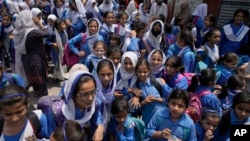Pakistan has temporarily shut down schools in most parts of the country to protect children from heatstroke and dehydration due to an ongoing climate-induced heat wave.
“At least 26 million children in Pakistan’s most populous province, Punjab, - or 52 percent of the country’s total number of pupils in pre-primary, primary and secondary education – will be out of school from 25 to 31 May,” Save the Children said Thursday.
The education department in Punjab cited a temperature surge and a prolonged heat wave as reasons for shutting down all public and private schools across the province. However, it said that schools “will be allowed to conduct examinations as scheduled, with necessary precautions to ensure the safety of students.”
On Thursday, doctors in major urban centers reported treating hundreds of patients for heatstroke.
This is not the first time extreme weather has disrupted educational activities in the South Asian nation, which has a population of about 250 million people.
In 2022, Pakistan’s southern and southwestern regions experienced devastating floods triggered by climate change-induced erratic monsoon rains, which affected 33 million people and halted education activities.
"Pakistan ranks fifth among the countries most affected by global warming,” Rubina Khursheed Alam, the prime minister’s climate coordinator, told a news conference in the capital, Islamabad, on Thursday. She cited recent unusually heavy rains, floods, and soaring temperatures.
Alam said 26 districts in Punjab, southern Sindh, and southwestern Baluchistan provinces are experiencing an intense heat wave, which will persist for at least a week.
She advised the public to minimize exposure to direct sunlight during peak heat hours and stay hydrated, warning that the extreme heat and dry conditions could spark bush fires and forest fires in vulnerable districts.
This past April was the wettest in Pakistan since 1961, with more than double the usual monthly rainfall, killing scores of people and destroying property as well as farmland.
Offiicials say due to climate change, temperatures in some of the affected areas in Pakistan have already reached close to 50 degrees Celsius (over 127 degrees Fahrenheit).
Meteorological Department officials said temperatures in northern and northwestern Pakistani areas would be “4-6 °C higher than normal" for the rest of the week.
Pakistan contributes less than 1% to global carbon emissions but bears the brunt of climate change.
Save the Children said the country “faces rates of warming considerably above the global average with a potential rise of 1.3°C–4.9°C by the 2090s, and the frequency of extreme climate events in Pakistan is projected to increase as well.”
The flooding in 2022 resulted in at least 1,700 deaths, affecting 33 million people and submerging approximately one-third of Pakistan.
“Let’s stop sleepwalking towards the destruction of our planet by climate change,” U.N. Secretary-General Antonio Guterres said after visiting flood-hit areas in Pakistan. He said Pakistanis were “facing a monsoon on steroids — the relentless impact of epochal levels of rain and flooding.”
The U.N. Children’s Fund, or UNICEF, said Thursday temperatures spiked to 43-47 degrees Celsius on Sunday across India’s many northern states, including New Delhi.
The agency warned in a statement that “the soaring temperatures across South Asia can put millions of children’s health at risk if they are not protected or hydrated.”
UNICEF noted that 76% of children under 18 in South Asia, about 460 million, were exposed to extremely high temperatures, with 83 or more days in a year exceeding 35 degrees Celsius. It estimated that 28% of children across South Asia were exposed to 4.5 or more heat waves per year, compared to 24% globally.





